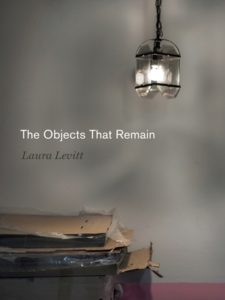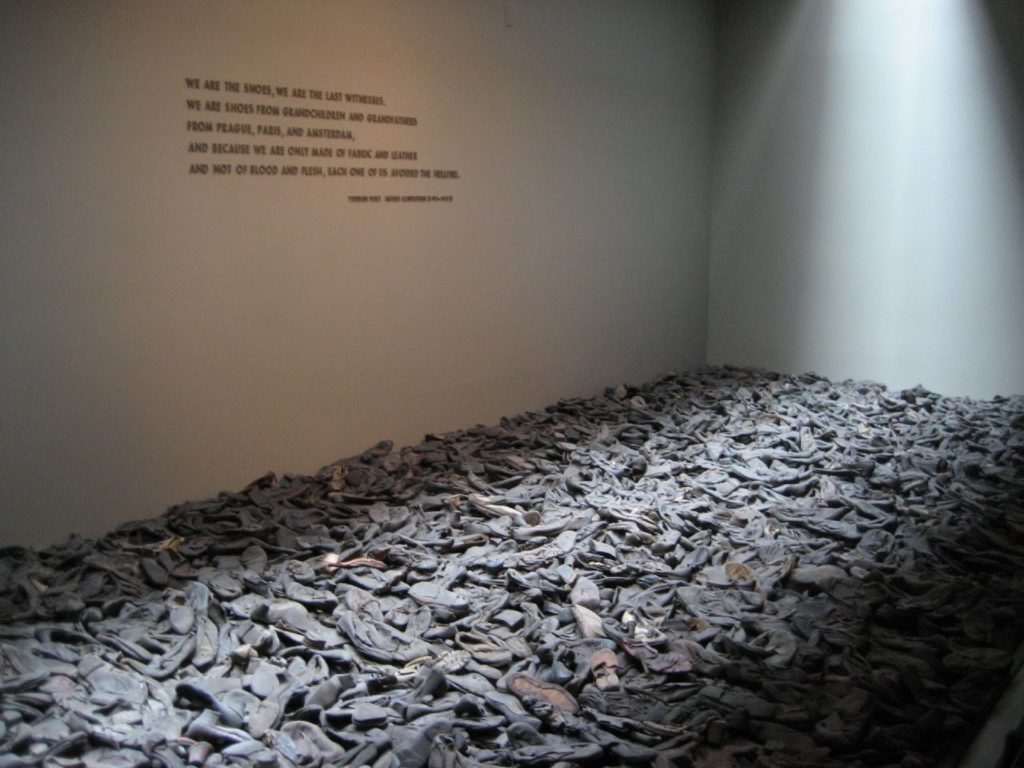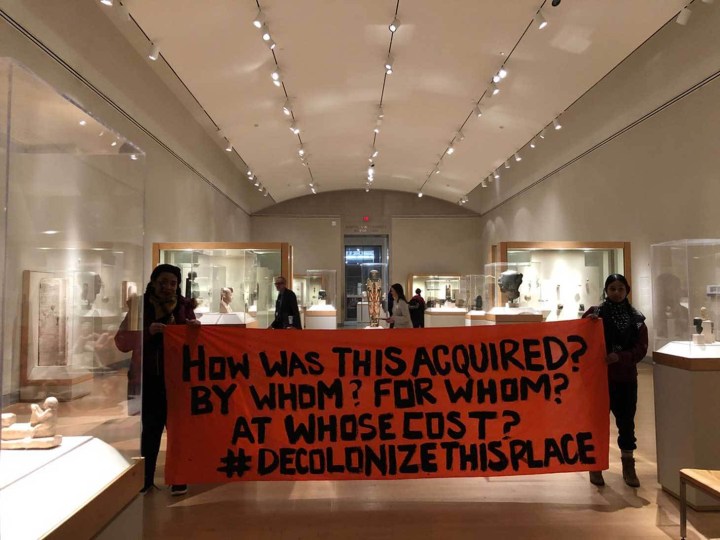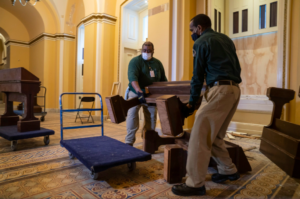On Objects, Trauma, and Loss
Kali Handelman interviews Laura Levitt about her new book, The Objects That Remain
I’ve known of Laura Levitt for years — she is a macher, mensch, and mentor enormously beloved and respected by her colleagues and students — but it wasn’t until her new book, The Objects That Remain (Penn State University Press, 2020), came across my desk that I had the occasion to dig in for a long conversation with her. That conversation (compiled here) felt like it could have gone on endlessly, continuing to think together about the odd echoes and intersections of our interests and commitments. Levitt’s depth of knowledge and range of expertise, her depth of feeling and range of connections, all come to bear in this beautiful, challenging book. The Objects that Remain is a rich weaving together of memoir with a study of memory itself that asks what kinds of power objects have, and why we care (or fail to care) for them the ways that we do. The book is now a powerful object in its own right, sitting on my desk continuing to provoke and draw me back in — I hope that this exchange will draw more readers into its powerful orbit.
***
K. Handelman: Your book is a personal and scholarly exploration of how experiences of violence, trauma, and suffering can be connected to material objects. You write about how personal belongings have been transformed into legal evidence — like the sweatpants you were wearing the night you were violently raped when you were in graduate school studying theology — and into contested and precious historical artifacts, like the possessions of Jews who were killed in the Holocaust. There is religion in both of these stories, even if it’s not the main subject. So, given our audience at the Revealer, and our own shared involvement in the field of religious studies, I wanted to ask you if you could say more about the role of religion — as history, as texts, as academic subject, as worldview — in your project. Particularly, you write about looking for both precedent and company in religion and I’d love to hear more about what religion is to you, as precedent, as company, or, maybe, as something else entirely?
 Laura Levitt: What is religion? This is a hard question even if I restrict my answer to the Jewish and Christian traditions I write about in my book. Once upon a time, I studied theology. It was then a way of thinking big, a meta-discourse that could contain all the ambiguities. It was a kind of grounding although, even then, I was not so sure. In the book I write about theology, a Jewish theology that I grappled with as a graduate student. Before I was raped, I thought that such a theology might have offered me some way to escape certain vulnerabilities. It did not. It could not do that for me. Instead, religion, or Judaism, has come to mean and to do something else. It is a community and a rich compendium of texts and practices that link me to other people, some from the past but mostly to those in the present and perhaps the future. Being able to engage with these communal legacies is what matters to me. As I demonstrate in the book, they need not offer answers to my questions; rather what they do is help me think through what I want and what I need in powerful ways that are not binding. This is what I do as I analyze a series of medieval Jewish texts in chapter one. Initially attracted to their vision of justice, I both engage and reject their conclusions.
Laura Levitt: What is religion? This is a hard question even if I restrict my answer to the Jewish and Christian traditions I write about in my book. Once upon a time, I studied theology. It was then a way of thinking big, a meta-discourse that could contain all the ambiguities. It was a kind of grounding although, even then, I was not so sure. In the book I write about theology, a Jewish theology that I grappled with as a graduate student. Before I was raped, I thought that such a theology might have offered me some way to escape certain vulnerabilities. It did not. It could not do that for me. Instead, religion, or Judaism, has come to mean and to do something else. It is a community and a rich compendium of texts and practices that link me to other people, some from the past but mostly to those in the present and perhaps the future. Being able to engage with these communal legacies is what matters to me. As I demonstrate in the book, they need not offer answers to my questions; rather what they do is help me think through what I want and what I need in powerful ways that are not binding. This is what I do as I analyze a series of medieval Jewish texts in chapter one. Initially attracted to their vision of justice, I both engage and reject their conclusions.
Let me say this differently. Although I initially went to these texts looking for precedent, the weight and authority of the tradition to anchor my commitments and my desires, this is not what I found. Reading those texts closely allowed me to figure out what I do and what I do not want. They offered a kind of companionship. It was a gift to think with them even as I came to different conclusions. And I repeat this process when I write about being in the potter’s hands in chapter three. I returned to the biblical text to see how this trope of the potter and being in his hands figured there. And here too I read and engage with traditional texts, a series of specific biblical passages. And, even as I do not share their conclusions, I value the interaction. In a sense, I have traded a vision of authority or the authorization of my work through an engagement with classical sources for a kind of companionship that need not control or contain my musings. I have come to value the process more than the outcome.
KH: I’d love to build on this idea of looking for company and companionship in religion. Two big themes in this book are companionship and uncertainty — and I wanted to ask what it’s been like releasing this book in a year where so many are without their usual companions (or spending a lot of time in the company of only a few people) and are reckoning with an enormous amount of uncertainty on both daily and existential levels. Have you been able to connect to people in new ways through writing and sharing this book during this deeply, painfully strange last year?
Levitt: In many ways my book speaks directly to this moment for all of the reasons you cite. We are profoundly isolated, and we have had to live with unprecedented uncertainty. We are all learning how to do so at the same time. Given this, I hope that, even in some small way, my book might be a comfort. I hope that it might help others as they struggle to keep going. I cannot say that I find any of this easy and I know that I say this as a truly fortunate person. I have a job that I continue to do and love. I have an income and a home and good health insurance and many friends and family and colleagues and students who I see regularly via Zoom. Yet I have to say that all of this is hard, but it is not impossible. This is part of what the book has taught me.
I have been extremely fortunate in terms of the launch of this book. I am overwhelmed by how warmly the book has been received. I have gotten so many joyous pictures and texts with friends, colleagues, family members, children, dogs and cats posing with the book. I know it is in good hands and good paws. This warms my heart. But more than this, I have begun hearing from people who are reading the book and how it has spoken to them. My hope was that my book might offer some companionship for others who have suffered and hearing from readers for whom this is the case has been extremely humbling and rewarding. For me these connections are the most important thing. I am honored by them.
KH: Continuing on the theme of uncertainty, at the end of the book you say that you have learned to live amid uncertainty, but that you can’t live without wonder. What does wonder mean to you? And how might others use that idea in their own thinking and lives?
LL: The first section of the book is called “Sacred Texts: The Red Parts” and this includes not only explicitly Jewish and Christian texts, but also works by the writers Maggie Nelson and Edmund De Waal. The subtitle for the section comes directly from Maggie Nelson. “The Red Parts” figures in her book of poems, Jane: A Murder, and of course it is the title of her memoir, or what she later described as “an autobiography of a trial,” The Red Parts. I call the companionship I found in these texts a form of what literary theorist and artist Svetlana Boym called “diasporic intimacy” in her work The Future of Nostalgia. This may or may not be figured as religious. It was not how I thought about it while writing but I think this makes sense. It is one way of looking at the surprise of tenderness having lost everything.
As I read your questions, I was struck by how much of my book can be read as “religious.” For me there were a series of religious moments that include my rejection of theology, something I write about explicitly in chapter two where, in the process of reading Maggie Nelson, I tell my story, and later, in my coming to consider the objects that remain as both evidentiary and talismanic (in Nelson’s words), or what religious studies scholar Jennifer Schepper Hughes describes as “object-entities.” For me these insights led me to the language of relics. I was interested in the rites and rituals of holding and critical engagement as powerful practices that can be animating. Such tender regard, as I argue, is what breathes new life into what are otherwise inanimate objects. And that regard is bound to the painful narratives, the terrible stories these traces help us tell. These animating labors can happen in both police storage facilities and at places like the US Holocaust Memorial Museum (USHMM). This form of material religion spoke to me. And although the term “relic” gets thrown around a lot, it is usually figured in disparaging terms, like the way that Peter Novick deploys this language to dismiss practices of Holocaust commemoration that he finds objectionable. I stay with the relics and ask how they are alive, what kinds of things they can teach us about what we can and what we can never fully know about the horrors a child’s sweater, a wool jumper, or a pair of sweatpants witnessed. As object-entities, these things are not simple evidence, they have qualities that we cannot control or contain. And for me, this is both humbling and powerful.

Shoes at the Holocaust Memorial Museum
These insights led me to appreciate something else that happened over the many years I worked on this book. I became aware of how, in the process of writing itself, there were things that happened, coincidental, serendipitous meetings, conversations, references that steered my work. Like the detective that Maggie Nelson writes about who describes being guided by the hand of God in his investigation of her aunt Jane Mixer’s murder, I too felt that I was not alone in the work I was doing. Perhaps, albeit in a less overt manner, I too had been guided in my work by forces I cannot explain. Of course, for me these serendipitous moments and insights are more defuse. There is no single divine figure ordering or guiding my process. I cannot believe that. But there are forces beyond my control. Some are terrible. I do not know why I was raped and my life was threatened. That can never be, for me, a part of any divine plan. I reject such notions. And yet this is not the whole story.
Letting go of certitude is hard. It remains a struggle. I still often wish for more control, an answer to why this happened to me. But to have an answer is far worse, I have come to believe, than having to accept that I cannot know. This letting go has allowed me to appreciate and take seriously those often-surprising moments of insight and recognition as a kind of wonder. And this too came to me as I have learned to resist that desire to be in control. But I also want to say something else about control and certitude. For those of us who have been brutally violated, agency is critical; we need to regain a sense of control in our lives, to appreciate that we can make decisions and act on them. But agency is tricky. It cannot be absolute. When it is, it can come at the price of self-blame. If only I had double-checked the back door. If only I had left the house as soon as I heard a strange noise. This is something I continue to fight against, to resist. It remains alluring but, as I have learned, it is ultimately profoundly harmful. It was not my fault that I was raped. And that sentence still feels hard to write.
KH: Continuing our thinking about caring for objects, I wanted to ask you also about another rich term you work with in the book: holding. You write at one point that the book is about “how we hold sacred objects.” First, I wanted to ask you about the meaning here of sacred — what makes an object sacred? And second, I understood you to be making an argument about how institutions hold and care for sacred objects. Your focus in the book is primarily on the USHMM, but I found myself, perhaps because I’m in London, thinking about the British Museum and the controversies about who owns objects like the Parthenon (or Elgin) Marbles and the moai from Rapa Nui (Easter Island). You mention the British Museum briefly in the book but I hoped you might say more about how you think we might weave questions about colonialism and racism into the conversation about holding and holdings?
LL: This is such a rich question and I need to answer it in parts, first in terms of the objects I write about and then in contrast to how Ariella Aïsha Azoulay writes about object in places like the British Museum. Objects held in police storage and in Holocaust collections are linked to the urgency of the violent crimes these artifacts witnessed and our need both to remember and to document these atrocities. My book attempts to make more explicit the compelling nature of material objects as holders of traumatic, painful, and violent memories. I am not interested in “national or communal treasures,” but rather tainted objects, once ordinary objects that, having been marked by violence become something else. The holding of such material traces in these collections enables forms of recognition, acknowledgement and critical engagement not once and for all time, but rather an ongoing process of reckoning. This process is what I talk about as “doing justice.” We do justice by continuing to tell stories. We return to these objects from an ever-shifting present. And, as such, these engagements are always only partial reckonings. Nevertheless, I believe they are necessary and important. We do justice to those who died and those who were violated, and we contribute to what Christina Crosby identifies as “a new horizon of justice and an underdetermined future.”
Your question also makes me think about Ariella Aïsha Azoulay’s recent book Potential History: Unlearning Imperialism, where she addresses these questions explicitly in terms of plunder and demands a radical reckoning. Azoulay argues that institutions like museums and archives are built on imperial ways of ordering time, space, and politics. And, in so doing, they often celebrate the new while destroying what came before. I find Azoulay’s argument compelling, but I am also aware of a tension. Once in custody, in the care of these institutions, all kinds of objects are treated with a kind of respect, often a culturally inappropriate version of “reverence,” but they are, nevertheless, attended to. And reading Azoulay’s book and then watching the beautiful film she made in relation to this project, “Un-Documented: Unlearning Imperial Plunder by Ariella Aïsha Azoulay,” again I was reminded of this tension, the taking and then odd revering of so many of these objects. Seeing the objects beautifully filmed, even in captivity, and then surrounded by music in Azoulay’s documentary haunts me. These object-entities come to life. Despite the overt and compelling argument of the film and the book, the beauty and power of these object-entities were overpowering. These artifacts, often ritual and communal in nature, held against their will even still seemed to overpower the film’s political message. They are the stars. It was mesmerizing to watch and take in their beauty and power even in the context of the museums that hold them captive. The film is all about the objects and they are stunningly captured on film as they stand on display in so many European and American museums. But what I want to say is that the power of these object-entities exceeds the way that they were deployed even in this film. Their presence is what stays with me. And this is a kind of wonder. And to be clear, I am not advocating for these pieces to remain in captivity. I simply want to acknowledge how powerful they remain even in these settings and this too is a part of the story. These are evidence of imperial plunder but, at the same time, still sacred objects.

Protest at the Brooklyn Museum
KH: I have thought about your book a lot since I read it, and have been thinking in particular about the meaning of custody and custodianship as you write about them. You talk about custody as a form of “tender care” enacted by everyone from museum curators to cleaning staff. I thought of the multiple valences of custody and custodians — children, police, museums — again when, on January 7, I saw footage of the cleaning staff whose job it was to clean up after the mob who had attacked the Capitol Building the day before. Those images of Black people literally cleaning up after white supremacists were so symbolically and politically charged, and really, I just wanted to ask you to say more about custody, its different forms and valances — for yourself and as a way of looking at how we interact with one another and material objects. How might we take more tender care?
 LL: I so love this question and wanted, throughout the book, to call attention to those who work behind the scenes, those who do the daily, repetitive custodial labors. These are necessary and essential practices that are often disparaged or over-looked and my hope was that in calling attention to them, I could make visible their power and importance. I am thinking of how the servant, Mrs. McNab, is so crucial to the restoration of order after “Time Passes” in Virginia Woolf’s To the Lighthouse. During the pandemic, we have learned anew the importance of so many “essential workers” whose labors had been taken-for-granted or remained invisible and under-valued for far too long. I turned to Joan Scott and her account of “the logic of the supplement” as a way of appreciating this tension. The importance and necessity of this work but also the ways that it is also considered superfluous. And, as you note, these labors are often raced as well as gendered. My hope is that by highlighting the importance of this work and those who do it, my book might help chip away at this disparagement.
LL: I so love this question and wanted, throughout the book, to call attention to those who work behind the scenes, those who do the daily, repetitive custodial labors. These are necessary and essential practices that are often disparaged or over-looked and my hope was that in calling attention to them, I could make visible their power and importance. I am thinking of how the servant, Mrs. McNab, is so crucial to the restoration of order after “Time Passes” in Virginia Woolf’s To the Lighthouse. During the pandemic, we have learned anew the importance of so many “essential workers” whose labors had been taken-for-granted or remained invisible and under-valued for far too long. I turned to Joan Scott and her account of “the logic of the supplement” as a way of appreciating this tension. The importance and necessity of this work but also the ways that it is also considered superfluous. And, as you note, these labors are often raced as well as gendered. My hope is that by highlighting the importance of this work and those who do it, my book might help chip away at this disparagement.
KH: You write with so much generosity and vulnerability in the book while also doing a great deal of rigorous and critical intellectual work. Discussing trauma and pain and memory in these ways is not, of course, standard convention in academia, and I wondered if, returning to the first question, you were also hoping to set an example or establish any kind of precedent yourself and of your own? What kind of work would you like to see come in response, or what kind of legacy would you like this book to have?
LL: This is the work I needed to do, that I was compelled to do. This is how I think and live and write and I wanted to share more fully my process with readers. I did this with the hope that some of what I had to say, and how I needed to say it, might resonate with other scholars and readers. I am not sure that everyone needs or wants or has to write like I do. What I want is more room for scholars to be able to write about what matters most to them in a mode that feels like their own. I want there to be space for writing that is not dictated by any one set of norms. I do not want to have only one form of scholarly writing. I think there are lots of different ways of writing and I want to respect that diversity. And I hope that writing like mine might be more a part of the mix.
Kali Handelman is an academic editor based in London. She is also the Manager of Program Development and London Regional Director at the Brooklyn Institute for Social Research and a Contributing Editor at the Revealer.
Laura Levitt is Professor of Religion, Jewish Studies, and Gender. She is the author The Objects that Remain (2020); American Jewish Loss after the Holocaust (2007); and Jews and Feminism: The Ambivalent Search for Home (1997). She is a co-editor of Impossible Images: Contemporary Art After the Holocaust (2003) and Judaism Since Gender (1997).